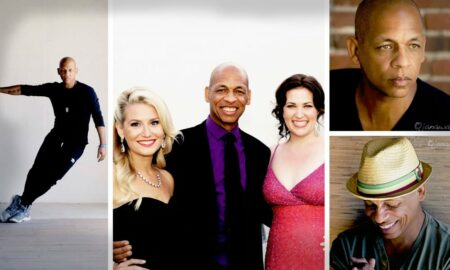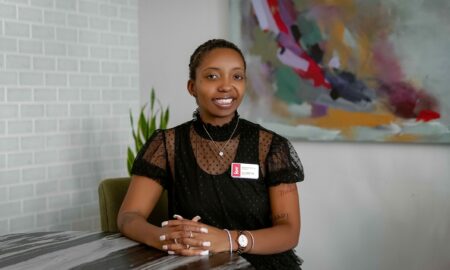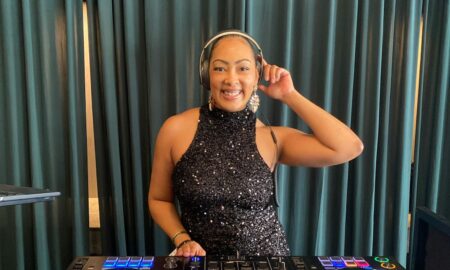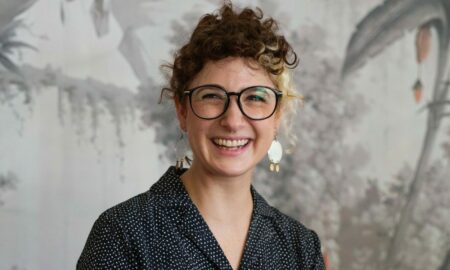 Today we’d like to introduce you to Sue Schroeder.
Today we’d like to introduce you to Sue Schroeder.
Sue, let’s start with your story. We’d love to hear how you got started and how the journey has been so far.
In her first year at Houston’s High School for the Performing and Visual Arts, a young Sue Schroeder was recruited into the Beverly Cook Dance Company. There she danced for a decade until Ms. Cook disbanded the company. Schroeder then danced with another company for a year but soon became restless. Her older sister, Kathy, had also been a member of Beverly Cook, and both wondered how best to pursue their muse. It wasn’t long before they decided to start their own company.
“After nine or ten years of making art in a particular way, from a particular perspective, and with a particular aesthetic, that’s what called to us,” said Schroeder. “We had to create our own company because that’s what interested us, and no one else was making dance in this way.” Christening the new company “Several” to signify the continuation of Cook’s art-making process – the last piece the company performed was called Several – the Schroeder sisters, along with two other former Cook dancers, christened their first performance space at a loft studio at 3221 Milam in Houston. The year was 1980.
Dual Homes: By 1985, falling oil prices impacted Houston and Core Dance’s landlord did not renew the lease. Its next studio space, DiverseWorks, burned down, and the one after that was an old office, complete with carpet and desks. Then a college friend – an Atlanta native who had returned to her hometown – called Schroeder and offered her the company’s current location in Decatur.
Global Citizens: A defining characteristic of Core Performance Company (the professional dance company within Core Dance) is that it tours.
Touring started as an artifact of collaboration. In the early years, Core Dance invited Austin-based Yacov Sharir to Houston, and in return, the Core Performance Company performed in Austin. Schroeder soon discovered there were touring rosters available to promote Core Performance Company’s work. Since then Core Performance Company has performed in 16 states. Soon after adding Atlanta as a second home, Core Dance was contacted by the Goethe Institute in Munich, Germany. They wanted to present German contemporary dance and asked Schroeder for assistance. Core Performance Company traveled to Germany in 1988 and has since toured ten other countries.
Professional Artists: Core Dance has long been a professional dance organization. Dance Artists started receiving salaries in 1986, administrative staff was added in 1990, and full benefits for all were added in 2011. Dance companies are frequently named after their founding choreographers; e.g. Merce Cunningham, Paul Taylor, and Alwin Nikolais. They are, after all, vehicles for their founders’ visions.
The same can be said of Core Dance, co-founded by Sue Schroeder and Kathy Schroeder Russell. But the legal name of this company is Several Dancers Core. And in that name is the vision. “When we formed, the natural order in dance was that choreographers, most of whom were white males, were masters, and dancers were subordinates,” said Schroeder, who co-founded Core Dance at the age of 23. “There was a lot of abuse going on in the dance world, and it was just accepted as the way work was made.”
But Schroeder wouldn’t have it. “Core” refers to an artistic partnership, and partners have included the company Dance Artists, other choreographers, composers, musicians, visual artists, set designers, lighting designers, et al.; Schroeder believes that art is always made richer through collaboration. “Success in art making, to me, comes down to truly collaborating, which only happens when you genuinely value people, give them a voice, and give them a seat at the table,” said Schroeder. “When people are valued, they buy in more, they connect more deeply with the work, they contribute more, they invest longer.”
Thus, Several Dancers Core. What’s in a name? Everything.
It’s one thing to decry the model of artistic dictator and pronounce yourself a collaborator, but it’s something else entirely to develop collaboration into a core competency. “Can you uphold personal values at work?” asked Schroeder. “It can be challenging, but for me, it’s much harder to live my work life differently from my private life.”
To strengthen the practice of collaboration, Schroeder developed a framework dubbed “Core Dance Cultural Practice.” Its five components inform both the artistic and business sides of the organization:
• Don Miguel Ruiz’s Four Agreements
• Liz Lerman’s Critical Response Process
• The Field’s Fieldwork Method for Feedback
• Marlene Johnson’s Guidelines for Cooperative Living
• The Formal Consensus Process
The practice aims to foster quality work and protect relationships. “We value mutual respect and want to offer feedback and communication that is meaningful,” said Schroeder. “We activate these tools every day to support these aspirations.” Although Schroeder had informally applied the framework for years, it wasn’t until she reached burnout in 2004 that the practice was formalized.
“It got to the point that I could no longer handle the volume of my workload,” said Schroeder, “so out of that moment, we developed a shared leadership model. Core Dance needed to lead in the same manner that art was made in the studio – collaboratively, sharing power, and creating true organizational health.”
38 years. 130 original works. What sets Core Dance choreography apart? Innovation, a social conscience, and an expertise in creating site-specific and museum work. Innovation in dance arises from constantly investigating and experimenting with what’s possible with human bodies in motion. Core Dance co-founder and artistic director Sue Schroeder and the Dance Artists in the company may spend months investigating how to wordlessly express a single human emotion; Schroeder is always seeking new ways to stimulate movement possibilities beyond one’s comfort zone.
“Our work is process-based,” explained Schroeder. “We’re not creating for an outcome. We’re discovering art as it’s being made. To innovate is to live; everything else is the opposite.” 2015’s Life Interrupted draws from the experiences of U.S. citizens of Japanese descent interned on American soil during World War II. It is the latest of many socially-conscious Core Performance Company works. At a time when some political leaders and other prominent voices advocate treating American Muslims in a manner similar to how American Japanese were treated during World War II, Life Interrupted could not be more relevant. “This is what artists do,” said Schroeder. “Art activates empathy. We are catalysts for re-envisioning the future.”
Why so much attention to social issues? Schroeder points to her mother. “She’s 89 years old and drives to nursing homes to volunteer,” said Schroeder. “Giving back runs strong in our family culture.” From a home of compassion into a profession where domination and abuse were prevalent, the combination of collaboration, community orientation, and a belief that the arts can heal has brought Core Dance to a place where creating socially-conscious work isn’t a privilege, it’s a responsibility.
Core Dance did not seek site-specific work, site-specific and museum work found Core Performance Company. Site-specific choreography is inspired and informed by the physical properties and/or the history of the space in which the work is developed and performed, while museum work is created by physicalizing the visual artist’s intent. An example of a site-specific work is Light Moves, which was created for the Architects of Air’s monumental inflatable structure installed at the University of Central Arkansas. And an example of museum work is Monochrome in Black, White, and Gray for the Museum of Fine Arts, Houston’s exhibit Picasso Black and White.
Core Performance Company’s drive to innovate and engage is satisfied by site-specific work. Core Performance Company collaborates with site representatives to bring alive their visions. Moreover, “we are interested in connecting our art-making to our audiences,” said Schroeder. In the early years, Sue Schroeder found it difficult to garner support from the Houston art establishment; the elders were unwilling to share the wisdom and knowledge that could help her.
“It was a time when the scarcity mentality ran strong,” said Schroeder. “They saw only one pie and a limited number of pieces. I decided I would go the other direction and pay it forward.” For Schroeder, it’s a spiritual practice to “unteach the starving artist mentality to most of the artists that have come through Core Dance. We’re artists. We create. It’s our passion and our careers. The uniqueness of our creative contributions should be celebrated. In this way, we become catalysts for more – more art-making, more support, larger audiences, increased recognition. In this way, we promote dance and art as valid professions.”
Today, Core Dance offers three programs that advance the making of art: Fieldwork, the Teacher Training Institute (TTI), and Summer Intensive. While Fieldwork and the Teacher Training Institute welcome all artistic disciplines, Summer Intensive is focused on dance professionals. These programs – along with Core Dance’s practice of producing non-Core Performance Company performances – help make Core Dance’s dual homes of Atlanta and Houston viable centers for dance.
“Dance thrives in communities where opportunities for creative and professional development are part of the landscape,” said Schroeder. “We envision Core Dance as a stimulus for the continued evolution of Atlanta and Houston as dynamic centers for dance, with the knowledge that dance as art-making is an essential element of the fabric of our human experience, connecting us to each other.”
Fieldwork is a unique facilitated forum for artists to share developing works and exchange feedback over the course of 10 weeks. A safe and rigorous space for creative exploration, Fieldwork provides objective, artist-to-artist, non-directorial feedback through a ‘test audience’ structure. Each session culminates in a performance with an audience. Developed by The Field of New York City, Fieldwork has been offered in Atlanta and Houston twice a year for the last 26 years.
Setting the standard for excellence, the Teacher Training Institute (TTI) develops the most qualified instructors in the region to teach art, dance, and kinetic learning in community enrichment programs. TTI, offered since 2001, imparts learning techniques that develop skills in children and adults who are challenged by traditional cognitive learning models. And TTI offers insight into how to teach within community-based settings, a unique approach, and methodology not often found in the education and arts education programs at the college level.
Core Dance’s Summer Intensive is a week-long program that brings in noted guest artists to inspire and invigorate dance professionals.
Has luck played a meaningful role in your life and business?
I don’t think there is luck involved. I believe it is about doing good work, being persistent and patient, being in for the long-haul and paying it forward in the community.
Contact Info:
- Website: www.coredance.org
- Phone: 404-373-4154
- Email: communications@coredance.org
- Instagram: instagram.com/coredance
- Facebook: facebook.com/coredance
- Twitter: twitter.com/coredances
- Other: snapchat – coredance1980 and Linkedin: coredance and vimeo.com/coredance










Image Credit:
Paige McFall, Lynn Lane, John Ramspott
Getting in touch: VoyageATL is built on recommendations from the community; it’s how we uncover hidden gems, so if you know someone who deserves recognition please let us know here.



















